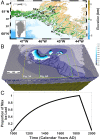Sea-level rise in Southwest Greenland as a contributor to Viking abandonment
- PMID: 37068242
- PMCID: PMC10151458
- DOI: 10.1073/pnas.2209615120
Sea-level rise in Southwest Greenland as a contributor to Viking abandonment
Abstract
The first records of Greenland Vikings date to 985 CE. Archaeological evidence yields insight into how Vikings lived, yet drivers of their disappearance in the 15th century remain enigmatic. Research suggests a combination of environmental and socioeconomic factors, and the climatic shift from the Medieval Warm Period (~900 to 1250 CE) to the Little Ice Age (~1250 to 1900 CE) may have forced them to abandon Greenland. Glacial geomorphology and paleoclimate research suggest that the Southern Greenland Ice Sheet readvanced during Viking occupation, peaking in the Little Ice Age. Counterintuitively, the readvance caused sea-level rise near the ice margin due to increased gravitational attraction toward the ice sheet and crustal subsidence. We estimate ice growth in Southwestern Greenland using geomorphological indicators and lake core data from previous literature. We calculate the effect of ice growth on regional sea level by applying our ice history to a geophysical model of sea level with a resolution of ~1 km across Southwestern Greenland and compare the results to archaeological evidence. The results indicate that sea level rose up to ~3.3 m outside the glaciation zone during Viking settlement, producing shoreline retreat of hundreds of meters. Sea-level rise was progressive and encompassed the entire Eastern Settlement. Moreover, pervasive flooding would have forced abandonment of many coastal sites. These processes likely contributed to the suite of vulnerabilities that led to Viking abandonment of Greenland. Sea-level change thus represents an integral, missing element of the Viking story.
Keywords: Norse; archaeology; glacial isostatic adjustment; sea-level change.
Conflict of interest statement
The authors declare no competing interest.
Figures




References
-
- Barlow L. K., et al. , Interdisciplinary investigations of the end of the Norse Western Settlement in Greenland. Holocene 7, 489–499 (1997).
-
- M. Rasch, J. Fog Jensen, Ancient Eskimo dwelling sites and Holocene relative sea-level changes in southern Disko Bugt, central West Greenland. Polar Res. 16, 101–115 (1997).
-
- A. Thorgilsson, The Book of the Settlement of Iceland (T. Wilson, 1898).
-
- Ó. Halldórsson, Eiríks saga rauða: Texti Skálholtsbékar AM 557 4to, Vol. 4. Hið íslenzka fornritafélag (1985).
-
- J. Arneborg, “Norse Greenland: Reflections on settlement and depopulation” in Contact, Continuity, and Collapse: The Norse Colonization of the North Atlantic (2003), pp. 163–181.
Grants and funding
LinkOut - more resources
Full Text Sources

